While we were writing the building description of this two-flat in the proposed Fairground Park Historic District in the O’Fallon neighborhood, we did a double-take. Is that…? Yes, that is. An owner of this striking building at 4147 W. Kossuth Avenue, built in 1916 by contractor J.W. Jones, covered the open false gable end in mesh to keep birds out. The neighboring building to the west has an identical feature, open, and seems clean. the two buildings to the east have identical features closed-in. So it goes.
The “Old Courthouse Players” will honor Veterans’ Day by presenting a radio-style play reading of My Dear Julia, the romance of Ulysses S. Grant and his beloved wife Julia, on Sunday, November 11, at 1:00 p.m. and again at 3:00 p.m. at the Old Courthouse in Downtown St. Louis.
Playwright and local historian NiNi Harris used memoirs and first hand accounts of the meeting, courtship and family life of Lieutenant General Ulysses S. and Julia Grant to tell the story of this famous romance. Ulysses and Julia met in St. Louis, were married in Downtown St. Louis, and returned to St. Louis throughout their lives. After Ulysses died of cancer, General William Tecumseh Sherman said to his widow Julia, “You were as true as the needle to the thread, in poverty as in wealth, in adversity as well as exaltation.”
The Players are a group of friends interested in local history and the preservation of local historic sites. They have presented play readings on the history of Prohibition in St. Louis, the Civil War in St. Louis, and the story of the St. Louis riverfront.
The play reading is approximately 40 minutes in length.
The plays are fashioned in the style of plays about events in St. Louis history that were presented on local stations during the early days of radio.
The play reading is free and open to the public.
by Michael R. Allen
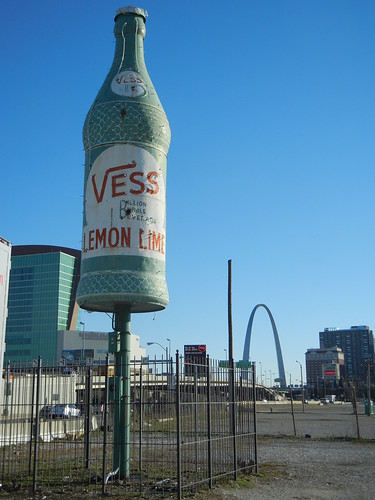
Now that the “Bottle District” — that mass of spread gravel north of our football stadium — is poised to become part of the Northside Regeneration project, perhaps it is time to evaluate the fate of the Vess bottle sign that gave the now-merged project its name. Dan McGuire of McGuire Moving and Storage, the longtime former occupant of a nearby historic warehouse building at Sixth and O’Fallon streets, invented the Bottle District trope in 2006 to market an ambitious mixed-use high-rise redevelopment project designed by architect Daniel Libeskind. The Libeskind plans are long gone, and now developers Larry Chapman and Paul J. McKee, Jr. are trying to market a now-cleared site between O’Fallon and Cole streets west of Broadway. What the bottle has to do with the new project is unclear.
by Michael R. Allen
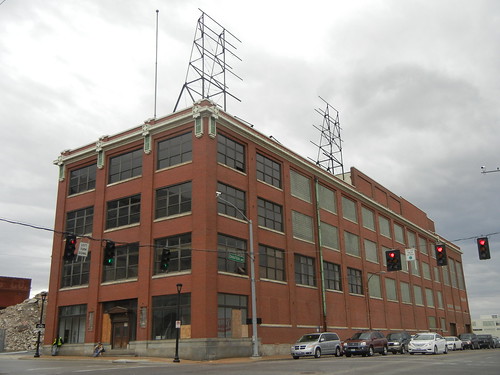
Perhaps right now the Pevely Dairy Plant office building at the southwest corner of Grand and Chouteau seems like the back half of the Titanic, shorn from the rest of the ship and poised to sink out of sight. On October 9, the city watched a distress call when the “P” from the neon sign on the roof fell crashing to the ground. Quickly wreckers from Ahrens Contracting removed the center of the sign and all of the letters, leaving the sign looking punched out. The west side sports a mangled hole, and the rest of the site is covered in rubble. Pevely’s death warrant already was signed by the city’s Planning Commission, which offered a Kevorkian comfort in its stipulation that the National Register of Historic Places-listed corner building could not fall until owner St. Louis University had obtained a permit to construct a supposedly equally meritorious new ambulatory care center.
The Belleville Historical Society will honor and celebrate the body of work created by architect Charles E. King in the Belleville area at a reception on Sunday afternoon, November 4th at 2:00 at the Alan J. Dixon Student Center on the campus of Lindenwood University (2600 W. Main Street). Artifacts from King’s period of work in Belleville and a photo display of his area designs will be a part of the reception.

King, a 1947 graduate of the University of Illinois School of Architecture, practiced in Belleville from 1947 until 1961 when his firm was purchased by Hellmuth, Obata & Kassabaum in St. Louis. During his fourteen years in Belleville, at least 36 of his residential designs and 19 of his commercial designs were built. All but two still stand today. Probably the most notable of King’s works in Belleville is the City Hall designed in 1957 and dedicated in 1959. In 1957, he also designed five buildings on the campus of Belleville Township High School, one of which is the Fine Arts/Cafeteria Building in which the November 5th reception will be held.
King, who preferred to design in a Mid-Century Modern Style of architecture, went on to a very prolific career and in 1991 was named of one of Architectural Digest‘s “Top 100 Architects.” He was also the recipient of many other professional awards.
King, a native of Louisville, Kentucky, died on August 16, 1993 in St. Louis at the age of 73. This retrospective of King’s Belleville area designs is open to the public.
Preserving Stained Glass
by Emily Kozlowski
St. Louis is built of brick — and glass. With the abundance of churches, this city has a fantastic supply of stained glass windows. I recently attended the session on identifying and preserving stained glass at the Missouri Preservation Conference. The talk was given by Stephen Frei of Emil Frei and Associates. The company was founded in 1891 by his Bavarian great-grandfather Emil and has been run by the family ever since. They are the leading provider of stained glass in St. Louis most definitely, but are also largely important to the Midwest as well.

by Michael R. Allen
This afternoon Cultural Resources Office Director Betsy Bradley will recommend that the Preservation Board adopt new standards governing solar collectors installed on City Landmarks and Sites and on buildings within Local Historic Districts. The board’s approval will allow the office to put forth new standards for public comment and then adopt a final version as official city policy. Today’s action could put St. Louis ahead of many other cities with historic districts. Nationwide, the preservation community is debating how to fix local ordinances written before solar panels were widely being installed. Although historic preservation and environmental laws are often compatible — and while historic preservation laws are environmental laws — recently there have been conflicts between new energy policies and practices and old approaches within historic preservation.
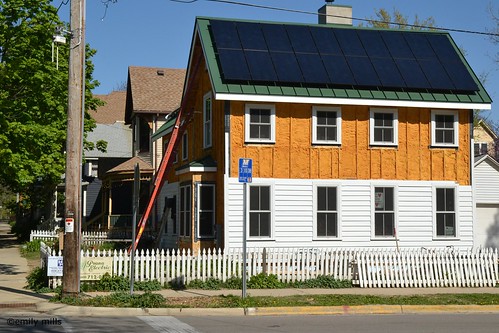
Locally, there has been at least one recent case in which the owner of a building within a local historic district initially faced denial by CRO of a permit to install street-facing solar panels, but won a new hearing and later approval from the Preservation Board.
by Michael R. Allen
In The Power of Place, Dolores Hayden champions the study and preservation of common urban vernacular housing as the best way to record the lives of most Americans. “Most can be learned from urban building types that the represent the conditions of thousands or millions of people,” Hayden writes. Yet Hayden finds that scholars are more interested in simpler rural and exotic urban types (the mythic flounder house is our local intrigue-builder). To some scholars, Hayden observes, “the best vernacular building will always be the purest, the best preserved or the most elaborate example of its physical type.”
Hayden’s observations can be counterbalanced by emergent material culture studies that widen the architectural history of cities beyond the showiest (prettiest?) vernacular buildings and those whose owners seek official landmark or National Register status (regulatory vehicles that enhance but do not replace cultural appreciation). Objectification of domestic architecture is far simpler using pure examples — we who practice architectural history can then shift the focus onto style, form and material so as to avoid messier discussions of class, race, use, power and alteration. Yet much housing production historically in St. Louis and other cities came through mass building practice. One of those practices was alteration by later, lower-income owners often strapped for cash and in search of a cheap fix.
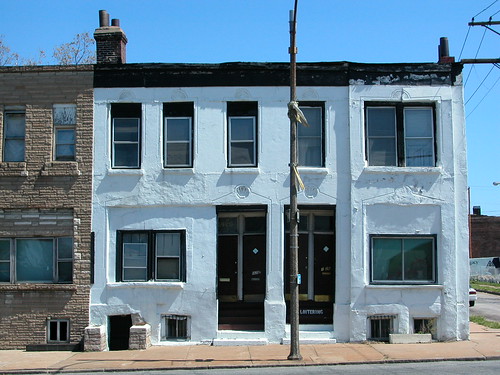
Cast Iron Storefronts Matter
by Michael R. Allen
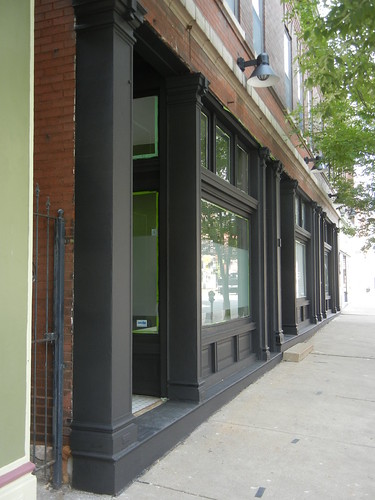
Now that my office is at the corner of Cherokee and Jefferson, I have occasion to slip eastward afoot (often for coffee at the Mud House). In the last two months, I have been delighted to find the owners of the two-part commercial building — and by two-part I mean one part store, one part flats above — at 2220-22 Cherokee Street have fully restored their cast iron storefront. The building dates to 1912 and its front is the product of the St. Louis Architectural Iron Company.
by Michael R. Allen

A distinctive building in the northern reaches of The Ville is no more. In late August, the city wrecked the two-story, mansard-atop-brick mass at 4159 Ashland Avenue. This strange specimen sat on the sidewalk line on a block where remaining buildings — fewer in number than ever — maintain a general setback of ten feet, and are residential. This building had traces of a storefront opening (see the painted, nearly-concealed I-beam above a new entrance at left) suggesting a commercial past.

